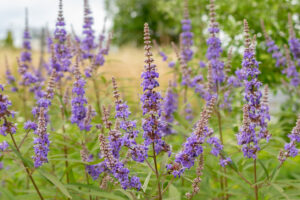Women during the menstruating years often struggle with one or more issues related to menstruation, including abnormal uterine bleeding, dysmenorrhea (menstrual cramping pain), premenstrual syndrome (PMS) and cyclic mastalgia (breast discomfort) related to PMS.
Abnormal bleeding can include heavy menses, long menses, short cycle, long cycle and no cycle at all. Any of these symptoms require an evaluation by a qualified practitioner and require a thorough medical history, select physical exam and possible laboratory testing, pelvic ultrasound and sometimes a uterine biopsy. PMS symptoms – whether emotional or physical symptoms can typically be easily assessed and diagnosed from a medical history without the need for testing. Menstrual cramping can fall into either what is called primary dysmenorrhea (a prostaglandin imbalance within the uterus) or secondary dysmenorrhea (typically caused by endometriosis, adenomyosis or uterine fibroids) which involves history, physical exam, possible imaging with a pelvic ultrasound and surgical diagnosis, and intervention in some cases.
 Knowing the specifics of what one is treating is especially imperative of abnormal uterine bleeding. If it is a simple cause such as not ovulating that is not related to a thyroid disorder or polycystic ovarian syndrome, chasteberry, aka Vitex agnus-castus can be an excellent choice due to its long tradition in the treatment of menstrual cycle disorders. It is thought that the main effects of chasteberry are its dopaminergic activity in the hypothalamic-pituitary-gonadal axis, leading to reduced prolactin secretion and/or the ability of chasteberry to stimulate the release of luteinizing hormone (LH) from the pituitary gland and mildly inhibit follicle stimulating hormone (FSH). The result is an indirect ability on the part of Vitex to raise or modulate progesterone levels.
Knowing the specifics of what one is treating is especially imperative of abnormal uterine bleeding. If it is a simple cause such as not ovulating that is not related to a thyroid disorder or polycystic ovarian syndrome, chasteberry, aka Vitex agnus-castus can be an excellent choice due to its long tradition in the treatment of menstrual cycle disorders. It is thought that the main effects of chasteberry are its dopaminergic activity in the hypothalamic-pituitary-gonadal axis, leading to reduced prolactin secretion and/or the ability of chasteberry to stimulate the release of luteinizing hormone (LH) from the pituitary gland and mildly inhibit follicle stimulating hormone (FSH). The result is an indirect ability on the part of Vitex to raise or modulate progesterone levels.
These mechanisms of action and the long tradition and previous research, led to the current study to evaluate clinical characteristics, quality of life (QoL) and effectiveness in patients with menstrual cycle disorders (MCDs) including abnormal uterine bleeding, dysmenorrhea and mastodynia/mastalgia related to premenstrual syndrome taking the Vitex agnus-castus (VAC) products Cyclodynon® or Mastodynon® in a real-world setting.
This was a single-center retrospective longitudinal cohort study of approximately 3 months using data obtained from healthcare data archive and telephone interviews. The main study variables were changes in bleeding, menstrual pain, breast tenderness and patients’ QOL.
The products used were Cyclodynon® (trade name of Agnucaston® in Russia) and Mastodynon® which are commonly used vitex products in gynecological practice outside of the U.S.. Both products contain “ VAC extract BNO 1095” in the same allopathic dosage (4 mg). Mastodynon® in addition contains five herbal substances in a homeopathic dilution (cyclamen, tiger lily, ignatius bean, blue cohosh and blue flag) and is typically given at a dose of 30 drops twice daily. Both products are used for the treatment of MCDs, PMS, and also mastodynia and are available as tablets and oral drops.
The results from 1700 women with a mean age of 30.2 years (±6.3) were analyzed. The most common MCDs were dysmenorrhea (43.8%) and mastodynia/mastalgia (21.1%). The three-month treatment with vitex extract substantially decreased the percentage of patients with irregular cycle (from 9.1% to 0.1%) and breast tenderness (from 39.9% to 0.8%). Improvement in bleeding intensity, frequency and menstrual pain was experienced by 83.4%, 79.2%, and 85.2% of the patients, respectively. When analyzed by disease category, these parameters improved in almost all dysmenorrhea patients, while they improved to a lesser extent in mastodynia/mastalgia patients. QOL improved in all aspects, but was in a higher proportion of dysmenorrhea patients compared to mastodynia/mastalgia patients.
Commentary:
Several clinical studies of vitex products have demonstrated a high potential to relieve menstrual cycle irregularities, painful menstrual bleeding, cyclic mastalgia, PMS and even menstrual-related migraines. It is important for clinicians, patients and consumers to realize that vitex is not a quick acting herb…and three months is often the amount of time needed to see if it works in these cyclic menstrual disorder related issues. The current study of real-world women in clinical practice demonstrate similar results as to those found in randomized clinical trials using vitex.
Common U.S. products are often standardized to 0.6% aucubin at a dose of approximately 200 mg per capsule.
Reference: Holler M, Steindl H, Abramov-Sommariva D, et al. Use of Vitex agnus-castus in patients with menstrual cycle disorders: a single-center retrospective longitudinal cohort study. Archives of Gynecology and Obstetrics 2024; 309:2089-2098

